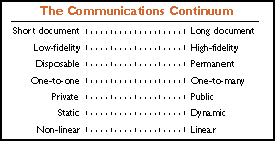

|
|
Use the communications continuum to manage changeby John Knapp, Binary Graphics, Inc. Seattle © 1997 Binary Graphics, Inc. All rights reserved worldwide.We are in the communications business and our customers are communicators. Some are professional communicators and some are not. Many of us are most comfortable when dealing with professional communicators like designers and print buyers, but more frequently than ever before we are dealing with non-professionals. These are individuals whose primary job function is not design, production or anything of the sort. They are busy business people who just happen to be responsible for getting a message across. We come in contact with these individuals on projects ranging from forms and stationery to collateral and annual reports. They have special needs which we must recognize and address. Certainly this is an industry in transition. Not only regarding the individuals with whom we transact business but in the nature of the communications pieces with which we get involved. These changes are legendary and a great deal of printing plant management's time is spent considering where they are and where they are going within this landscape. Changes naturally occur as projects go in-house and as run-lengths, content and mediums change. We cannot ignore these changes. In fact, we should (obviously) act upon change and use it as a lever for growth. But many peoples minds numb a bit at the tumult we are experiencing. As I consider change, it helps me to divide the world of communications in the following way. Consider where you fit in this continuum, what changes are going on at that place today and tomorrow, and consider where on this continuum you might optimally want to position your business. 
Here is some description about these variables: Number of Pages
Print Quality or Fidelity
The Documents Practical Life Span
The Intended Audience Size
The Public Nature of the Audience
Is the Document Subject to Change
The Way in Which The Document is Used
|